Please enjoy the following chapter, “Trails of Wrathful Waters,” from David Curran’s book Hiking for Fun and Pain (2016, Oconee Spirit Press).
Despite my chosen hobby of walking in the woods, there are other ways to experience the wilderness than by hiking on a trail. In the interest of giving other outdoor pursuits a fair assessment, and, more importantly, to accommodate a brother-in-law, I entrusted my fate to whitewater rafting. This is not a sport I would choose of my own accord, but being married, one acquires companions with whom association would be unlikely otherwise. Gary is a congenial type but bears a close resemblance to Fidel Castro and has an affinity for Harley-Davidson motorcycles that I am somehow lacking. We must have appeared to be a bizarre couple traversing around, because I am your basic Bob Newhart kind of guy. Fortunately, Gary and I shared enthusiasm for outdoor pursuits, although his was more water-related than land-based. Despite my being raised in Florida, with the ocean on three sides and having worked for an organization dedicated to creating lakes in the Tennessee Valley I have never really cared for water recreation.
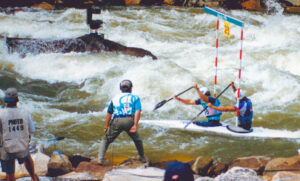
However, Gary, being from Missouri, certainly welcomed the opportunity to sample the joys of mountain rivers so lacking in his native environment. As one always interested in new experiences, I was more than willing to give it a try. In southeast Tennessee, there is a stretch of the Ocoee River so perfect for whitewater activities that it was used for the kayaking events in the 1996 Olympics. The Ocoee is one of the rivers managed under the TVA system, but for many years its potential for whitewater rafting was not apparent because the river seldom flowed freely. The power company prior to the existence of TVA had built a flume of five miles to carry the water from upstream to a downstream power house, leaving only a long segment of bare rocky riverbed. When TVA closed the flume for significant repairs, the water roared joyfully and merrily down the rocky gully. At this point, kayaking enthusiasts discovered one of the best whitewater stretches in Eastern United States. When the flume repairs were finished seven years later, and after some prickly negotiations between TVA and concerned recreation interests, agreement was reached to share the water with these activities.
In order to partake of this wonder, we availed ourselves of commercial outfitters. Gary had experience at this sort of thing, but as a total novice, I was very attentive to the instructions on proper technique. As the fifth person in our raft was a trained guide, the likelihood of our getting into serious trouble seemingly was at a minimum. The four-hour trip was one of sheer joy as we descended through rapids that rocked us roughly and gave an edge of danger to the prospect of being flipped into this unforgiving maelstrom. To inspire awe and some fear, the major rapids had such colorful names as Grumpy, Double Trouble and Table-saw.
This was a new way for me to savor nature and its forces, ignoring the fact that our raft was guided by a seasoned oarsman and that a road paralleled the river. We accepted the challenge of being battered jerkily about in the rapids with the ever-present prospect of sudden submersion in angry torrents if our steward guide or inexperienced crew made a costly blunder. Between the episodes of high water and intense paddling, we enjoyed stretches of tranquility where the flow was gentle and we could enjoy the beauty of the green canyon that drifted gently past with little effort on our part. While trudging along the trail there is rarely any real and imminent danger comparable to what one faces as swirling rapids loom and one wonders if a flimsy craft and all its occupants will be present at the other end.
The intensity and focus required on a continuous basis on the effort at hand is worlds away from a stroll in the woods where one’s mind can wander far from the serene setting. Of course, I seldom do any rock-scrambling and never any mountain climbing with technical gear that would necessitate a similar concentration. White water is thrilling but, for me, to be experienced only briefly, as my goal in the wilderness is to seek tranquility.
Nevertheless, I did take my two teenage daughters on this trip down the Ocoee and they watched in despair as their father was thrown overboard at the first turbulence we encountered. A delusion of appearing heroic before one’s offspring sometimes meets a harsh reality. But the memories were many from this trip, including a lingering time at a swimming pond where they could enjoy the rare peace of gentle water in this angry river.
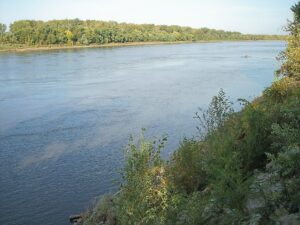
Gary, being a generous soul, arranged for me to enjoy the delights of the Missouri River on one of our many family visits to the Show Me State. He had a large canoe and gathered together all the necessary equipment and supplies for a river journey on the mighty Mo. We put in near the bridge of the I-40 interstate over the Missouri and planned to go the thirty-five miles downstream to the state capital, Jefferson City. The Missouri River at this point is free flowing, but progresses indolently under normal conditions, so to make any significant progress we had to put our backs into the rowing. As we gently glided down river, there were ample opportunities to leisurely watch the occasional bird and enjoy the serenity of the tree-lined banks. Having traveled on the Tennessee River on several occasions, I expected to see homes and other manmade structures on the river banks, but the Tennessee River is essentially a series of lakes, with the water levels carefully controlled by my friends in Reservoir Operations. On the other hand, only limited flood control exists on this stretch of the Missouri River and few individuals would build on the flood plain. Consequently, there are mile after mile of forested shores with only sparse evidence of human settlement—an echo of the time Louis and Clark traveled the area.
I must confess that I find most river travel rather boring. When something of interest is seen, it is at a tantalizing distance that remains unexplored. Once an unusual feature is encountered on the trail, unless it is a distant view, it can be thoroughly explored or in some cases battled with. However, this languorous river was not without its periodic excitement in the form of tugs pushing large barges. What made this gripping for us was the wakes created in their passage, as we had to be alert to steer the canoe directly at them and ride over their crest or our fragile craft would be swamped.
This was a two-day trip [Missouri] and Gary knew of a small island in the river where we could camp. Calling it an island is probably generous, as it was little more than a sandbar without a tree or significant vegetation. But as no floods were expected, it served us as an ideal stop for the night, untroubled by fellow humans. There was sufficient driftwood on the island to make a very satisfactory bonfire in the evening. We slept peacefully at night, only hearing an occasional tug with its barges going by and hoping its sonar was adequate to avoid the diminutive shoal that was our temporary home. The whole trip was an excellent way to view a section of Missouri that I had not realized was so well preserved and to visualize Mark Twain’s life on the river.
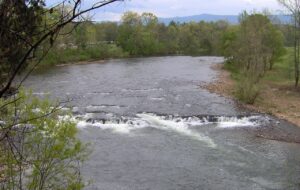
With the adventure of the Ocoee and the serenity of the Missouri behind us, we were ready for even greater challenges of the wild waters of the wilderness. In the course of researching for the next Missouri family visit to Tennessee I found tourist brochures touting the glories of the Nolichucky River in upper Tennessee. This is a river without dams on its upper reaches, so it is unpredictable whether the river will be a satisfying torrent or a tiresome series of ponds to drag a craft across. The commercial outfitter had the usually large rafts with a guide, but also provided small one-person rafts that they called funyaks. The brochure stated that you had to be twelve years old to handle a funyak, and I decided that if a twelve-year-old could hand it, a funyak shouldn’t be too difficult for me and effortless for Gary. Little did I know then that twelve-year-olds in Unicoi County are made of stern stuff. They must be a far cut above your average couch potato, video-playing adolescent. The very kindly outfitters also provided a campsite at their base, and Gary and I innocently spent a night next to the gently babbling liquid dragon we would dare to confront the next day.
The next morning dawned with overcast skies and intermittent light rain. This was disappointing, but as we were going to be on the river, getting wet by rain didn’t seem to matter greatly. The outfitters hauled our gallant party of fun-seekers ten miles up the river. We had large rafts for most of the group, but eight of us were in our individual funyak. Our flotilla of funyaks included an experienced guide to instruct us in the proper techniques. At the initial rapid, we were told that the funyaks would go first, followed by the big rafts to pick up any of us that didn’t make it through the rapids in our small craft, which didn’t strike me as very comforting at this stage of the event. Our guide said,
“OK, on this rapid keep as close to the left bank as you can and when you get to the bottom row for all you’re worth to the right side.”
As the second funyak, I entered the rapid and almost immediately knew I had little control over my fate. The turbulent water rushing down between the many boulders bounced me to and fro, but I did manage to keep the little raft pointed in the right direction as I flayed away with my two-ended paddle. When I hit the whirlpool at the bottom of the rapid, I attempted to faithfully execute my instructor’s direction and did succeed in rowing to the right bank to join the other funyak. Regaining some composure and feeling pride that I had come through that wall of water solely on my own efforts, I awaited the others.
Eventually all the funyaks appeared except for the one piloted by Gary. After an anxious wait, I was alarmed to see Gary’s funyak float by upside down and no Gary in sight. One of the more difficult prospects in life is to explain to a sister-in-law what happened to her husband on an outing, particularly as this was the sister who elected to stay behind on the Alum Cave Bluff hike. With relief I saw one of the larger rafts come by with Gary sitting sheepishly in the bow like some Captain Ahab who didn’t get the whale. This first rapid was where the outfitter had set up a camera to take a series of three pictures to sell to us after the trip. In Gary’s case, the first picture showed him braving the rapid, the second was of him turning over and the third showed only a tennis shoe sticking out of the frothy turbulence.
There were some six major rapids on this trip, and on each Gary and I were determined to make it through without hitting the drink again. This beautiful canyon could be only enjoyed for short spells until our guide would gather us together again like a mother hen with her chicks and explain patiently what was expected of us to survive the next rapid. With each rapid I gathered more confidence, along with a growing resolve to never again submit myself to such a situation where my control was very marginal. I am sure a veteran of whitewater sports would enjoy all this greatly, but my pleasure was far outweighed by the pain of the unknown, coupled with the uncertainly that I could perform adequately at the next rapid.
Finally, we came to the last rapid only a short distance from the base camp. I had made the entire trip without being thrown from my misnamed funyak. The last rapid appeared only as a two-foot drop-off, mild compared to what we had been through. However, unknown to me, its tricky swirls gave funyaks more problems that the previous ones, and camp personnel would gather on the shore to watch the show of paying customers upended and separated from their small rafts.
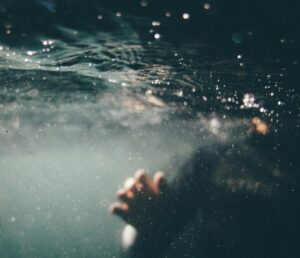
As I approached the rapid, I lost control and went into the rapid sideways. Everything seemed to happen in slow motion and I was powerless to control it. As the funyak dropped on its side, it rapidly filled with water and soon flipped over, throwing me into the churning waters. Under I went even with a life jacked on. As I came to the surface I discovered that the funyak was on top of me, and since no amount of thrashing could get it off of me and I stayed under water. As my breath started to run out, the thought crossed my mind that this is what it is like to drown and that I was going to die there in that river. Finally I was able to push the funyak away and popped to the surface for air, coughing and gagging. As I struggled to gasp in the sweet air, I heard above the roar of the river laughter from the camp personnel who were enjoying my travails. I am not by nature a violent person, but if I could have gotten one of them by their mirthful throat at that instance I would have joyfully squeezed hard.
Gary and I did survive the trip and with its many dangerous experiences. The later retelling of the adventures in calmer settings made it worthwhile and provided a lasting satisfaction for having accomplished it. However, the punishing river was not yet finished with me. We had started the day in rain, but it cleared at noon and the sun gave welcome warmth to our trip. When one hikes in the East in the summer sunburn is not a concern, but we had spent several hours in the river without shade and in swimming trunks. Shortly after the trip, I developed a fierce sunburn that provided a lingering pain and severely limited my capacity as a host for the family visit.
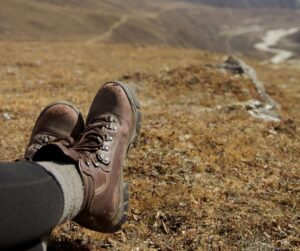
These misadventures convinced me that I wanted to experience the wilderness from the trails on solid earth rather than know the highs of conquering white water. A friend did try kayaking and I would discuss it with him to gain a further sense of this sport. He trained at the swimming pool at the local YMCA, where he would practice flipping over his kayak and righting it again, as all skilled kayakers can do. One day I saw him with a nasty cut on his forehead and I asked him what happened.
“Well Dave, I was kayaking on the Obed when I turned over in the rapids. I tried to right myself but the force of flowing waters are greatly different than the calmness of the pool at the Y. I couldn’t right myself and unbuckled from the kayak to swim to the surface. However, in this frothy world, I had no sense of direction and swam instead to the bottom and hit my head on a rock.”
Later he told me he gave up the sport because he could practice it only once a month and to become good enough to enjoy it with the necessary skills, he would have to do it at least once a week. This left me grateful for hiking as the skills are so low that as one can do it after months or years without facing life threatening situations because of a lack of practice. However, the memory of turbulent water pulling at me in a wild river provided another reminiscence of life away from civilized life.
David Curran was born in Pennsylvania and lived there until age eleven when his family moved to Florida. He has a BA from Florida State University and a MA from the University of Kentucky. He worked for the TVA for 28 years in the Knoxville, Tennessee, area. Afterward, he was an instructor at Carson-Newman College and Tennessee Wesleyan College. David lives in Powell, Tennessee, with his wife Lola. The couple once served as missionaries for the International Mission Board-Southern Baptist Convention in Paris, France. They have two daughters, Gina and Elizabeth, and two grandsons, William and Andrew.
Click on the cover below to find David Curran’s book Hiking for Fun and Pain:
**Featured image: PublicDomainPictures, Pixabay
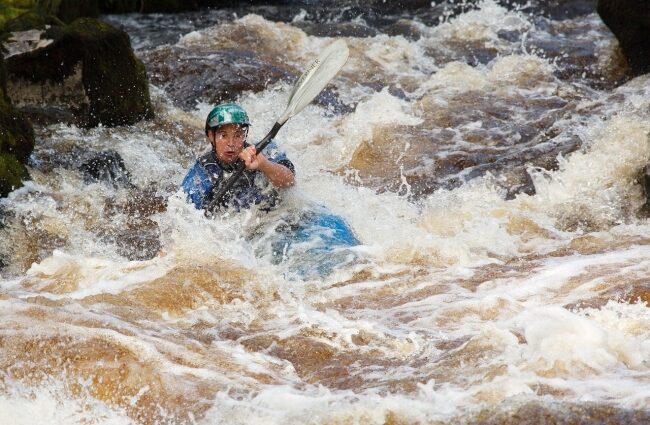

You are braver than I am. Under no circumstance would I attempt a raft, kayak, or a funyak. I agree wholeheartedly… a nice woodland path is the way to go!